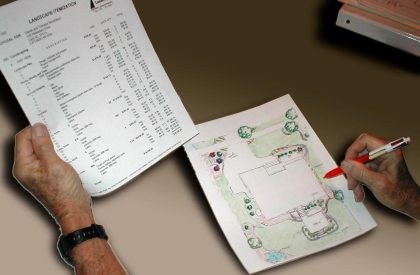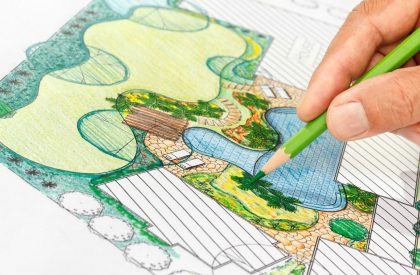

Designing Your Dream Landscape
Leisure Landscapes sends a design professional to your home for a customized design. We’ll interview you to determine your needs and preferences, assess the strengths and weaknesses of your current landscape and design a landscape solution.
This solution is prepared in our design studio and presented to you in the form of a color concept drawing and a detailed itemization of the labor and material necessary to complete the job. To move the project to the next “install” phase, you sign the contract and return it with the initial payment, normally half of the quoted installation price.
Once the contract and payment are received, you are scheduled for the installation.
The Design Process
The design process starts with drawing a base line, or plot plan of the current landscape layout. First, we make an overall appraisal of the site. What is the balance of lawn to garden to living areas? What are the natural light and shade conditions? What are logical traffic patterns to enter and traverse the landscape? Where are the landscape living areas?
From this assessment a concept drawing of the proposed solution is prepared. First the living areas are located; the patios, decks and walkways. Materials-stone, brick, concrete or wood- are selected that are consistent with the home’s design and bridge the indoor and outdoor spaces. Particular attention is paid to sight lines from major indoor and outdoor living areas to provide privacy screening and a backdrop for the ornamental plantings. Next, the surface area devoted to lawn, gardens and living area is redrawn to provide the appropriate balance for your site and style of living. The interface of these three areas is designed to flow fluidly from one to the other in a way that invites the eye to enjoy its contours. Planting material is selected next, starting with the largest and going to the smallest. First sited are evergreen varieties for screening and backdrop needs. Next, ornamentals and specialty plants are placed to add interest and variety to the landscape. Finally, perennial and seasonal flower beds are located to provide the color excitement that sets off main focal points of the landscape. The design may even incorporate special features like stack-stone retaining walls, fountains, ponds, waterfalls, or statuary.
Designing Your Watering Distribution System
Once your landscape plan is determined, your watering distribution system is designed. Water requirements for the lawn and garden may best be met with automatic irrigation. The type of sprinkler heads and their location is determined to provide a balanced application of water with the most efficient distribution system. For example, large lawn areas are best handled with rotor-type heads, while pots on the deck are best irrigated with direct drip systems. Location of the backflow preventer is sited for best distribution and located in an area that can be easily screened. A rain sensor is provided to ensure that the system doesn’t actuate during rainy periods, conserving water. Your watering bill is further reduced by an advanced Rainbird water system controller that meters out the water to the exact specifications for your landscape needs. This portion control ensures that your landscapes get just what it needs, but no more. We can even include remote control actuation that allows us to perform your irrigation system performance inspection without the necessity of your being home or leaving the garage open! The irrigation design drawing is provided with your system permit application and also serves as the installation blueprint and basis for the system ‘As Built’ documentation.
Lighting
Finally, we can design drama into your landscape with accent lighting. Fixtures are located to emphasize the architectural details of your home, softly accent the plants, trees and walkways and provide additional security for you and your guests. Low-voltage systems are used to ensure safety for children and pets, as well as reduce your operating cost. Lighting controllers include advanced features such as photocell actuation and timer-controlled cycles.

